CM-15A: Full-Range: Feedback in a Speaker
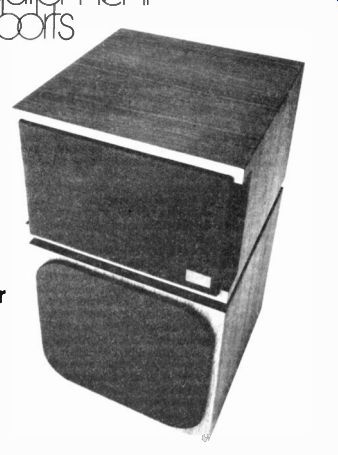
The Equipment: CM-15A, a full-range loudspeaker system with amplifier feedback (servo) connections, in walnut-veneer enclosure. Dimensions: 32 by 17 inches (front), 17 inches deep. Price: $500. Warranty: five years parts and labor. Manufacturer: CM Laboratories, 327 Connecticut Ave., Norwalk, Conn. 06854, USA.
Comment: The Model CM-15A is a very unusual loud speaker-in both its design philosophy and its sound. It starts out as a three-way system with a woofer, midrange driver, and dual tweeters aided by a piezoelectric super tweeter, but it has an additional feature that makes it be have in a way that is profoundly different from what one would expect. That feature is, of course, the feedback control that is applied to the system.
Negative feedback is normally used in amplifiers, where its benefits include lower distortion and lower output impedance. Seeking to minimize speaker distortion as well, the designer of the CM-15 (and the LWE designs that pre ceded it before CM Laboratories bought LWE's loudspeaker business) has found a way to include the speaker in the amplifier feedback loop. This arrangement (which is purely electronic, requiring no external transducers at the loudspeaker) allows the speaker to "talk" to the amplifier and tell it when the acoustic output departs from accurate correspondence with the amplifier input signal. The amplifier responds virtually instantaneously with a corrective drive to the speaker.
If the CM-15A is to be used with an amplifier not made by CM Labs, some internal modifications to the amplifier are necessary. The manufacturer informs us that all CM dealers are competent to perform the modifications. As an alternative (that, incidentally, can void no warranties) CM offers a "black box" (price $75) that makes all the connections. We tested the system with the CM-912 power amplifier, with which it is designed to work.
This speaker is equipped with some interesting controls. In addition to the usual, continuously adjustable balance knobs for the midrange and tweeters, there is a ROOM GAIN control that regulates bass response to suit room dimensions. For small spaces the ANECHOIC setting (which gives the flattest response) is recommended; for larger rooms swoop and AUDITORIUM settings, each of which raises the frequency of maximum bass reinforcement, are provided.
In our listening room. the ANECHOIC position was preferred, as was a halfway setting for each of the balance controls.
(This can be improved upon, as we will see later.) The lab used the same room setting with the balance controls--which can turn their drivers fully off-wide open.
--------------------
Due to the special nature of this model, the test procedures used at CBS Technology Center had to be modified somewhat. It was not possible to carry our pink-noise testing below 63 Hz without damage to the woofer. This result is predictable: The feedback system increases power and attempts to maintain flat output, even in an anechoic chamber (where the testing is done). A sweep-signal check of frequency response shows a strong bass output that re mains nearly flat to about 26 Hz-a result that our listening tests handily confirm.
The system is very efficient, producing reference output (94 dB at 1 meter on axis. 200 Hz to 6 kHz) for just 0.8 watt input. Yet it can accept a continuous 100-watt input (for an output of 112 dB) without excess distortion, with pulse power reaching a level of 166.5 watts average (333 watts peak-the amplifier's limit) for an acoustic output reaching 117 dB. The dynamic range, therefore, is excellent. Moreover, the sound is so clean that we found our selves listening at levels approaching these figures. We noted also that the recovery from high-level pulses is excel lent; there is virtually no audible hangover.
Third-octave frequency response of the CM-15A as measured in the CBS anechoic chamber is smooth, but with a strongly rising high end and a moderate peak around 5 kHz. This characteristic makes white noise extremely bright and harsh. The balance controls, to our ears at least, flatten this nicely. But we got even better results by running the drivers wide open and applying tone-control equalization, which the unit accepts unusually grace fully-without the sense of strain or ancillary response peculiarities that often result from over-equalization. Probably a graphic equalizer would do even better. But any such equalization must come before feedback. High-frequency dispersion is good, with tones in the neighborhood of the upper limit of hearing remaining audible to about 40 degrees off axis. Oddly enough, the system sounds slightly better off axis than dead on, such small colorations as there are becoming less noticeable as one moves to either side. This presumably contributes to the fine stereo imaging that we observed.
The impedance curve shows peaks at about 65 and 350 Hz and dips to 7.5 ohms at 110 Hz. There is a secondary trough at about 1.5 kHz, where the value approaches 4 ohms, the manufacturer's rating of the system. The load is thus safe for just about any amplifier, though obviously there is no provision for driving extension speakers in parallel with the main ones.
This-as the dimensions indicate-is a massive loud speaker. While it cannot easily be made inconspicuous, its appearance is sufficiently composed to allow it to blend well into its surroundings. One significant help is that the servo system, in a sense, "corrects for" the speakers' position in the room, increasing flexibility of placement. (Be careful to allow access to the controls on the back-the CM-15A is no lightweight.) As we have said many times before, the perfect speaker does not yet exist (if it ever will), and no one speaker is for all tastes. In this light we would characterize the sound of the CM-15A as bright and sharply etched-most suitable for the person who likes to listen to music in detail. It will reproduce almost anything you would want to hear from your system and recordings, and maybe some things that you would prefer not to hear. Putting the matter succinctly, it is an extremely accurate transducer. And for a not-too-hefty price it holds its own against some of the best speakers around.
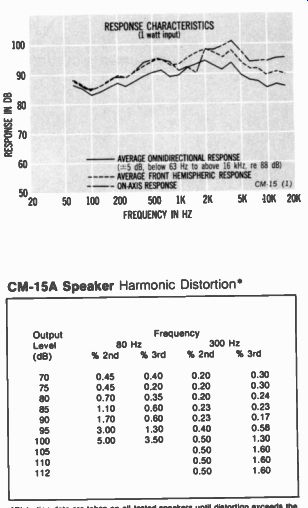
------ CM-15A Speaker. Response and Harmonic Distortion
Distortion data are taken on all tested speakers until distortion exceeds the 10% level or the speaker produces the spurious output known as buzzing, whichever occurs first.
---------------
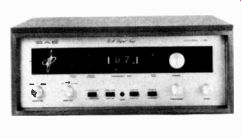
Strange, It Doesn't Look Like the 6-6
The SAE digital tuner shown at the head of our January-issue report on the Mk. VI-B was, in fact, a lower-priced model, the Mk. VIII. Here with apologies to any readers who may have been confused by the differences between the front panel as described in the text and that shown in the illustration-is the real Mk. VI-B.
---------------------------------
++++++++++++++++++++
Technics SL-1500: It Just Plays the Record
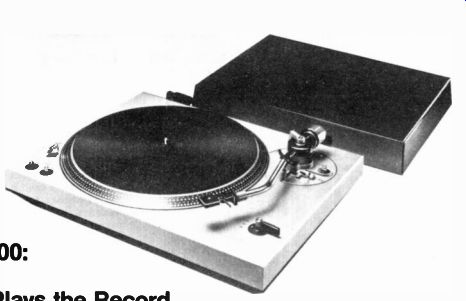
The Equipment: Technics SL-1500, a two-speed (33 and 45 rpm) manual turntable with integral tone arm and base, and dust cover.
Dimensions: 14 1/2 by 17 3/4 inches (top) by 5 1/2 inches high; 16 inches high with dust cover fully open.
Price: $199.95. Warranty: two years parts and labor. Manufacturer: Matsushita Electric, Ltd., Japan; U.S. distributor: Panasonic (Matsushita Electric Corp. of America), 1 Panasonic Way, Secaucus, N.J. 07094.
Comment: Electronic direct-drive turntables have been with us for some time now, and many of us are inclined to take their characteristics for granted: excellent speed regulation, low wow and flutter, practically nonexistent rumble-and a high price. With the SL-1500, "the direct drive turntable for people who can't afford direct-drive turntables," the folks at Panasonic have come up with a significant price reduction, and they have done so by simplifying manufacture and eliminating frills rather than by compromising performance. Tests made at the CBS labs show that the SL-1500 is in the same ballpark as the SL 1100A (HF test reports, September 1973). In fact, the newcomer actually excels the earlier model in some areas.
The SL-1500 has exactly one moving part (excluding the tone arm, of course): The platter itself, which weighs in at 3 lbs. 4 oz., is the rotating part of the motor. The stator assembly is a part of the base. It's hard to see how a basic drive system could be made much simpler.
The only assistance offered to the user in handling the tone arm is a cueing lever, which is easily accessible and is smooth and well damped in its operation; there is no automatic start and no automatic shutoff. A selector switch near the arm can choose 33, 45, or OFF. At the left front corner of the base are two knobs (one for each speed) for fine-speed adjustment. In the lab the adjustment ranges check out at -7.4% to + 7.2% at 33, -3.1% to + 5.7% at 45. Just in back of these knobs is a prism that casts a strobe light on the edge of the platter, which is appropriately marked with rows of dots for both 50- and 60-Hz AC power. The unit is effectively shock-mounted and is equipped with the low-capacitance wiring and cables needed to accommodate CD-4 demodulators. The over-all styling is simple, pleasant and serene.
The SL-1500 requires a few seconds for its speed to stabilize after initial turn-on. From then on, its rotation is rock steady, a fact that the unmeasurable speed deviation recorded by the lab confirms. Flutter (ANSI/IEEE weighted) measures 0.05% average (with an instantaneous peak value of 0.1%). Rumble, measured with ARLL/CBS weighting, is -64 1/2 dB, within 3 1/2 dB of the best figure we have yet found. The tone arm is virtually without friction-a property that, in our listening tests, allowed a somewhat recalcitrant CD-4 cartridge to track with reasonable accuracy some discs on which there previously had been unacceptable sonic breakup. The 10-Hz resonance of the arm (tested with a Shure V-15 Type III cartridge) is well damped, showing a mere 1 1/2 -dB rise. As the "Additional Data" chart shows, error in stylus-force settings is slight.
There is no provision for adjusting the antiskating for the type of stylus-not even a table in the instruction manual. (Elliptical styli generally develop a little more skating force than conicals. slightly less than CD-4 types.) The matter seems to be critical only for some CD-4 pickups, so the discrete-disc listener probably should experiment with antiskating compensation to achieve optimum results from his cartridge.
The antiskating mechanism itself, which allows a some what smaller range of compensation than we have found to be typical, delivers a force that is nearly proportional to the knob setting throughout its range.
On balance, we must credit this turntable with being outstanding in most of its performance even if it is merely good in one or two areas. Those who demand the ultimate in convenience may find it too spartan and single-minded.
But if your highest priority is reproducing music from disc-rather than pampering yourself-the SL-1500 de serves serious consideration.
------------------
Technics SL-1500 Turntable--Additional Data
Stylus-force gauge accuracy (grams)
Setting | Measured
0.5 1.0 1.5 2.0 2.5 3.0 3.5
0 450.95 1.45 1.95 2.45 2.9 3.4
---------------------------
+++++++++++++++
Top-of-the-Line Headset from Stax
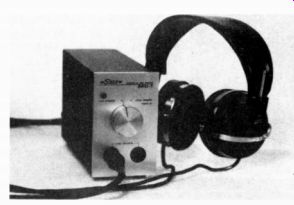
The Equipment: Stax SRX Mk.3 Ear Speakers, and electrostatic stereo headset with SRD-7 impedance-matching/ switching adapter in metal case. Dimensions: (adapter unit) 4.5 by 2 7/8 inches (front), 7.5 inches deep plus clearance for controls and connections, with 2-foot amplifier cable; headphones have 8-foot cable that plugs into adapter.
Price: $144.90.
Warranty: one year parts and labor. Manufacturer: Stax Industries, Ltd., Japan; U.S. distributor: American Audioport, Inc., 317 Professional Bldg., 909 University, Columbia, Mo. 65201.
Comment: Stax electrostatic headphones have been available in Japan for some years and, though local distribution has been extremely spotty, have built a considerable reputation among the more adventurous of American audiophiles. Now, thanks to American Audioport, they should be more readily available.
The SRX Mk.3 is a new design, having a thinner diaphragm than other Stax models, a feature intended to result in fuller and more accurate bass response. The adapter, which requires a power-line connection, supplies the polarizing voltage necessary for an electrostatic head set and matches the low impedance of amplifier speaker terminals to the high input impedance of the transducers.
The front panel of the adapter is fitted with two six-pin sockets to accommodate two Stax headsets. A large knob in the center of the panel switches the polarizing voltage and the audio on and off. In the off position, audio is fed to four terminals on the back of the adapter that duplicate the amplifier loudspeaker connections. Thus turning the phones on automatically disconnects the loudspeakers. A pilot light shows when the adapter is on.
The headset itself is fairly light in weight (10.5 oz.) and has earphones that are vented at the back-offering, therefore, little isolation from sounds in the room. By the same token, a person within several feet of a listener wearing these phones would have no difficulty in recognizing a familiar selection. While the earpieces are not heavily padded, they bear gently on the ears and are quite comfort able. The tradeoff for this comfort is the relative ease with which the unit can be dislodged by movements of the wearer's head.
The sound of the SRX Mk.3 is clean and accurate, so much so that the unit is very unforgiving of faults in the program material that one might find tolerable listening via loudspeakers. FM tuner hiss and disc surface noise prove very unpleasant, but clean program material is re produced with pristine clarity. Like other electrostatics, this model is relatively inefficient, so fairly stringent demands are made on the amplifier.
Though headphone frequency response is partly a function of the coupling between the earpieces and the particular listener's ear, we found bass fundamentals sound clear and distinct down to about 30 Hz. At the opposite end of the spectrum, response seems flat to about 15 kHz, falling off to inaudibility at about 17 kHz. In between, there is no audible evidence of peaks or dips. Dynamic range is also very good; loud transients attack and decay gracefully except possibly in the presence of extreme high-frequency energy. And in these cases, of course, even the finest phono cartridges find themselves in extrem is.
After listening for a time through the Stax we could al most forget that we were wearing a headset. The chief re minder really is the failure of material recorded for loud speaker reproduction to blend into a convincing sonic image. But this is scarcely the fault of the SRX Mk.3-except for its merciless clarity, which makes the experience unusually frustrating. This can be coped with, at the expense of "moving back" from the music, by rolling off the treble slightly. More germane, however, is the fact that with suitable material these headphones offer an astonishing listening experience.
+++++++++++++++++++
Kenwood's KR-9400: A Feature-Loaded Super Receiver
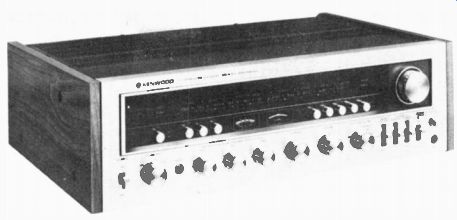
The Equipment: Kenwood Model KR-9400 stereo FM/AM receiver in metal case with laminated wood ends.
Dimensions: 22 by 6 7/8 inches (front), 14 1/4 inches deep plus clear ance for controls and connections. Price: $749.95.
Warranty: two years parts and labor, shipping prepaid.
Manufacturer: Trio Electronics, Japan; U.S. distributor: Kenwood Electronics, Inc., 15777 S. Broadway, Gardena, Calif. 90248.
Comment: The KR-9400 is a high-powered receiver capable of excellent performance and loaded with features.
Let's get directly to them. The tuning dial is very wide but is not very finely calibrated (except for the ubiquitous logging scale, which in our experience most users seem to find something of a nuisance if, indeed, they use it at all). The large tuning knob at one end handles well; at the other end is a row of pilot indicators for the selected program source plus one to indicate whether a stereo pilot is present when FM is selected.
Below the center of the dial are two meters: one for conventional center tuning, one that can be switched to indicate signal strength, multipath, or signal deviation. (For AM tuning, only the signal-strength function operates, of course.) This adds up to an unusually comprehensive complement of functions. In the signal-strength mode the second of these meters reads full scale for even fairly weak signals-meaning that it is intended to tell you how marginal a really marginal signal is (which is useful) rather than how strong a strong one is (which matters little). In the multipath mode it can be used with an antenna rotator, tuning the antenna for maximum meter deflection. Signal deviation is essentially a measure of the station's modulation level. The instruction manual suggests use of this mode for recording (in conjunction with your deck's meters), but we found the calibration too difficult to read for this suggestion to be very useful.
To the left of these meters are ON/OFF pushbuttons for FM MUTING, TONE [control] DEFEAT, and FILTERS (high and low). The FM section is so sensitive and the FM muting set so low that we could find few spots in our station-crowded dial where it would mute, though we could find some fairly noisy spots where nearby channels overlapped. To the right of the meters are five more ON/OFF buttons: MULTI-PATH and DEVIATION (these two referring to meter functions, of course), FM DOLBY NR, AF MUTING, and LOUDNESS. The AF (audio frequency) muting simply drops output by about 20 dB (18 1/2 dB in our sample, as measured by CBS). The Dolby switch is an equalizer, compensating for the difference between the 75-microsecond de-emphasis built into the FM-tuner section and the 25-microsecond de-emphasis required for correct balance in Dolby broadcasts.
This switch alters the sonic balance of the signal from any program source and does not switch the connections for a Dolby adapter. (More of that in a moment.) Below the dial panel are, from left, an ON/OFF lever for AC power, a rotary speaker switch with five options (OFF/ A/B/A + B/C) for controlling the three sets of speaker connections on the back panel, and a stereo headphone jack (which is live in all positions of the speaker switch). Next are three tone controls (bass, midrange, and treble) with detented positions calibrated in 2-dB steps of cut or boost. The balance control, which is not detented, also is calibrated in nominal 2-dB steps though of course the extreme position (10) in each direction completely cuts off one of the channels. The volume control is detented and arbitrarily calibrated from 0 to 10.
The input selector has positions for AM, FM. PHONO 1, PHONO 2, mic, and AUX. Next are four levers: MODE (STEREO/REVERSE/MONO), TAPE MONITORS (SOURCE / A/B), TAPE DUBBING (SOURCE / A-TO-B/B-TO-A), and SOUND INJEC TION (ON/OFF). This last is a mixer that will combine what ever signal the selector is set for with the tape feed when the dubbing switch is in either of the dubbing (A-To-B or B ID-A) positions. Next to the INJECTOR Switch is a MIX LEVEL knob, and below it is a mono phone jack for the mike input.
Note that this is not a mike feature crudely adapted from public-address and store-casting equipment, but one with a great deal of versatility for the home recordist. If you want to use the receiver as a PA system, with a mike, you need only switch the selector to mic and control speaker level with the volume knob. The mike signal goes through the regular preamp circuitry, reaching the tape without the special connections required on some receivers; the mixer is unusually versatile in that it can be used for any pro gram source, not just the mike.
The back panel is surprisingly uncluttered for so feature laden a receiver. There are the usual pin-jack pairs for in puts (PHONO 1, PHONO 2, and Aux) and for the input and output connections to handle two tape decks, plus DIN sockets for both decks. In addition, there are pin-jack pairs - for the output to and return from a Dolby adapter. These jacks are supplied with jumpers, because the front panel has no quasi-tape-monitor switching to bypass the Dolby jacks when the FM-Dolby feature is not in use. (Remember that the front-panel switch alters only effective de-emphasis.) If you do attach a Dolby box to the jacks, you would have to turn its Dolby circuit off for normal listening. If you also want to use the Dolby unit with a recorder-or are using the Dolby-FM feature built into some recorders-you can follow the instruction manual's suggestion that these same Dolby connections be used. Then, however, you have to use the tape-monitor (or record/play) switching on the deck or Dolby adapter to choose between tape and source and must choose equipment with some sort of straight through switching option for listening to non-Dolby sources. This makes for a rather complicated system; it is better, in our opinion, to connect the Dolby-plus-deck components to one of the tape-monitor connection sets, leaving the Dolby jumpers in place and saving those connections for use should you ever want to hook a third tape deck into the system-which could be a strong plus among avid recordists.
There are three other pin jacks on the back panel. One is an FM detector output (for a quadriphonic adapter, should a discrete FM broadcast system be adopted); the other two feed out signals for scope analysis of multipath in tuned FM signals. The antenna terminals have knurled nuts with screwdriver slots and accept bared wires or spade lugs. Either 300- or 75-ohm FM antennas can be used; there also is a terminal for an external AM antenna, though the usual ferrite loopstick is built in. A grounding screw accepts bared wires gracefully, and spade lugs can be used. The speaker connections (again, for three stereo pairs) are spring-loaded and engineered for bared leads. Switched and unswitched AC convenience outlets (one each) are provided.
----------------
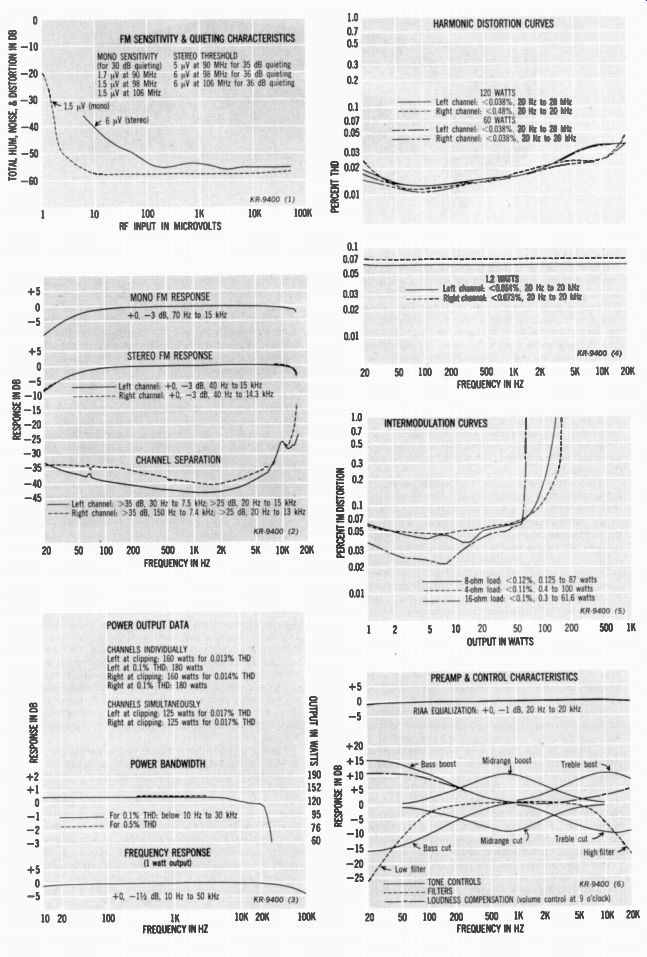
---------------
The amplifier section is indeed a hefty brute. It meets its rating of 120 watts per channel at 0.1% harmonic distortion handily at all frequencies and at all measured power levels. With such a low distortion rating, some amplifiers fail to make it in our -20 dB (1%) power test-in this case at 1.2 watts-because of crossover distortion and/or noise. But all the CBS measurements on the KR-9400 in this test are more than 25% below the spec. And at the other extreme of the dynamic range, the receiver will pump out up to 180 watts (which is beyond clipping) before the distortion rating is exceeded. Since the lab had to drive the amp beyond clipping to reach 0.1% THD, little extra power was developed before distortion shot up to our standard 0.5% for power-bandwidth measurements. For this reason, only the central portion (around 1 kHz) of the 0.5% curve was measured.
In terms of intermodulation distortion, however, the lab data are not as impressive. Kenwood rates the KR-9400 at 0.1%, without specifying output level. Though inter modulation does stay below this figure throughout what might be considered the normal operating power range, even at 4 ohms it rises above the figure in our test sample before rated power is reached. And at 8 ohms (the impedance specified for the power rating), intermodulation rises sharply above about 100 watts. That's still plenty of power, only a fraction of a dB below the 120-watt rating, but it does raise a question about the usefulness of the rating.
The lab's noise measurements also are not quite as good as those published by Kenwood, but here the test method seems to supply the explanation. The lab measures with the volume control at its maximum setting- which, in our experience, manufacturers often do not. Presumably Kenwood has used an alternative technique. In any event the lab figures represent excellent noise performance, if not the exceptional (or, at -93 dB for the high level inputs, almost incredible) performance suggested by the manufacturer's specs.
The FM quieting curves for both mono and stereo are excellent. Quieting of total hum, noise, and distortion is 50 dB by the time a stereo input has reached little more than 50 microvolts or by the time a mono input has reached only 2.5 microvolts. In the signal-strength range encountered in typical suburban locations, stereo quieting is around 55 dB while that of mono broadcasts approaches 60 dB. These figures, combined, mean that-for a receiver--the KR-9400's dial is unusually crowded with listenable quiet stations. Alternate-channel selectivity is excellent-as the lab measurement confirms, though it is not quite as good as Kenwood's spec. Deep-bass response of the FM section is not as flat as we would like (though of course the FCC's station performance standards them selves don't extend below 50 Hz); separation, though it does not quite meet the spec, is measurably and audibly excellent. The AM tuning section performs unexceptionably.
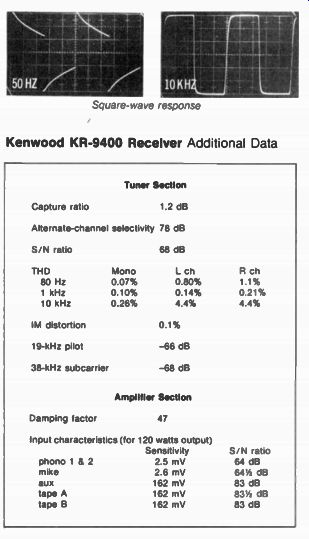
---- Kenwood KR-9400 Receiver, Additional Data
It should be obvious that such complaints as we have are almost exclusively with Kenwood's specs, rather than its product. We would, perhaps, have liked monitor-type switching in the Dolby connections; less-equivocal dial calibrations would have made tuning easier; high-blend noise cancellation for weak stereo FM broadcasts is conspicuous by its absence in so feature-filled a design. But these are minor points. Essentially the KR-9400 is both extremely capable and extremely versatile. The mixing feature in particular is one of the best of its type we've seen. This is a super receiver.
++++++++++++++++++
The Model 25, Jensen's Top Speaker
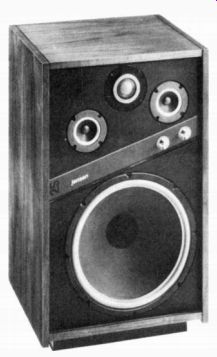
The Equipment: Jensen Model 25, a full-range loud speaker system in enclosure.
Dimensions: 18 3/4 by 31 inches (front, including integral base), 15 3/4 inches deep.
Price: $239.
Warranty: five years parts and labor. Manufacturer: Jensen Sound Laboratories, Div. of Pemcor, Inc., 4310 Trans World Rd., Schiller Park, Ill. 60176.
Comment: The Model 25 is the most sophisticated member of Jensen's new "optimum performance concept" line of loudspeakers. It is, not incidentally, the largest and most expensive of the line. The concept involves improvements in the drivers as well as an unusually wide range of adjustment in the balance controls for the midrange drivers and tweeter.
With its removable two-tone grille cloth, divided by a dark, slanted bar across the middle, the Model 25 is not visually reticent, but the harmonious browns in which the scheme is worked out prevent garishness. The particleboard cabinet is faced with an attractive veneer of real walnut. The smoked-plastic bar can be removed for access to the balance controls, which are mounted beneath it. As the dimensions indicate, this is a speaker too large for bookshelf mounting; floor placement puts the tweeters at about 8 inches below ear level for normal seating.
The Model 25 is a three-way system using two midrange drivers with a single tweeter and with crossovers at 1 and 5 kHz. As characterized by tests in the CBS anechoic chamber, the system is quite efficient, producing the standard output of 94 dB of sound pressure level, or SPL (200 to 6,000 Hz, at 1 meter on axis), for an input of 1.7 watts. A steady input of 80.6 watts at 300 Hz for an output of 111 dB is accepted by the unit without buzzing or excessive distortion. Pulse power reaches 268.7 watts average (537.3 watts peak)-the limit of the test amplifier-without excessive distortion. Maximum SPL under these conditions is 119 dB, indicating an excellent dynamic range. The measured nominal impedance is 6.7 ohms (at 90 Hz), with the impedance rising gradually with frequency. The bass-resonance impedance peak is at about 60 Hz.
In listening we found a robust bass and a somewhat distant perspective to be the dominant characteristics of this loudspeaker. Over-all the sound is warm and well blended-transients are somewhat softened, and instruments tend to merge into a homogeneous sonic structure.
But the range of adjustment in the balance controls allows the listener to change the character rather markedly. That for the midrange has greatest effect (lowering output by up to about 4 dB with respect to its maximum setting) in the octave below 1 kHz but also makes some alteration in response far into the treble. The tweeter control has an adjustment spread of 5 dB or more over most of the range from 3 to 20 kHz, exceeding 15 dB at some frequencies in the CBS tests. It also has some minor influence on response as low as 500 Hz. The lab found the frequency response flattest with the midrange control set halfway and the tweeter control fully to the right.
Jensen has an ingenious color coding system for these controls to indicate their effects on the respective drivers.
Each driver has a surround of its representative color: blue for the woofer, yellow for the midrange, red for the tweeter. Each control is surrounded by concentric rings of blue and one other color. Thus, as the midrange control is turned from left to right blue becomes weaker and yellow stronger; for the tweeter, red grows stronger and blue weaker as the control is turned.
But, balance controls notwithstanding, frequency response of the Model 25 departs considerably from flat ness. There is a peak in the lower midrange that imparts a certain guttiness to violas and cellos, followed by a trough in the upper midrange. The output has secondary peaks around 5 and 10 kHz, declining smoothly after that but still audible at 18 kHz. Toward the opposite pole, bass out put holds up well to about 40 Hz, where doubling begins to take over. White noise is reproduced with a throaty weightiness, but the highs retain sufficient brightness and are well dispersed to about 40 degrees off axis, at which point some falling off is observed. The omnidirectional frequency response, as measured in the CBS anechoic chamber, remains within ± 5 dB from 35 Hz to 12.5 kHz.
Like virtually any loudspeaker, the Model 25 is not equally at home with all kinds of music, nor with all kinds of listeners, for that matter. Its personality is very much in the Jensen tradition, which stretches back some quarter century. It produces a "big" sound with no skimping in the bass. And, within limits, its controls offer more than aver age flexibility for tailoring that sound to your room and tastes. If these considerations are high on your priority list, by all means listen to the Model 25 and the junior members of the new Jensen line.
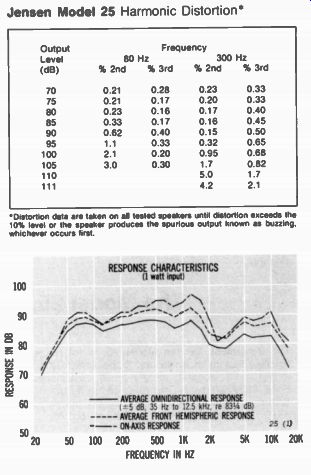
--------- Jensen Model 25 Harmonic Distortion; Output Frequency
Level 80 Hz 300 Hz
------
(High Fidelity, Mar. 1976)
Also see:
The Best Tape Recordings You'll Ever Make--Robert Long and Edward J. Foster; How-to with graphic aids
Noise Reduction Equipment: Robert Long, A comparison of devices to hush our sonic universe